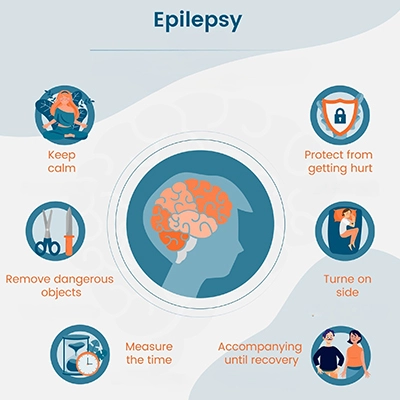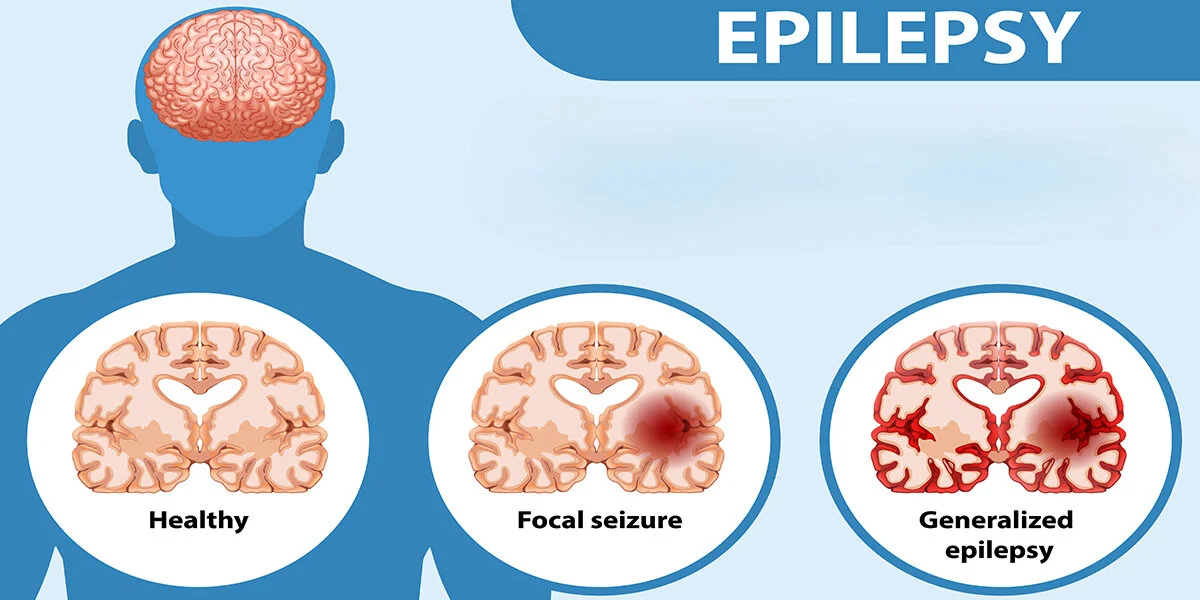Epilepsy: is a neurological disorder characterized by recurrent and unpredictable seizures, which are caused by abnormal electrical activity in the brain. These seizures can vary in severity, duration, and manifestation, and they may involve altered consciousness, convulsions, muscle spasms, or other unusual behaviors.
Types of Epilepsy
There are several different types of epilepsy, each characterized by distinct features and patterns of seizures.
Some of the common types of epilepsy include:
- Idiopathic Generalized Epilepsy: This type typically begins in childhood or adolescence and is thought to have a genetic basis. Seizures often involve both hemispheres of the brain and may include absence seizures (brief lapses in awareness), myoclonic seizures (brief muscle jerks), and generalized tonic-clonic seizures (loss of consciousness and convulsions).
- Focal (Partial) Epilepsy: Focal epilepsy originates in a specific area or focus within one hemisphere of the brain. Seizures may have a wide range of symptoms depending on the location of the focus. These can include focal aware seizures (consciousness is retained), focal impaired awareness seizures (altered consciousness), and focal to bilateral tonic-clonic seizures.
- Temporal Lobe Epilepsy: This is a type of focal epilepsy where seizures originate in the temporal lobes of the brain. Seizures often involve complex partial seizures with altered consciousness and unusual behaviors or sensations.
- Frontal Lobe Epilepsy: Seizures originate in the frontal lobes of the brain and may cause complex movements, behaviors, or motor symptoms during seizures.
- Occipital Lobe Epilepsy: This type involves seizures originating in the occipital lobes, which are responsible for visual processing. Seizures may manifest as visual disturbances or hallucinations.
- Parietal Lobe Epilepsy: Seizures originate in the parietal lobes and may result in sensory disturbances, such as tingling, numbness, or unusual sensations.
- Lennox-Gastaut Syndrome: This is a severe form of childhood epilepsy characterized by multiple seizure types, intellectual disability, and behavioral problems.
- Dravet Syndrome: Dravet syndrome is a rare, severe form of epilepsy that typically begins in infancy and is often resistant to treatment.
- Juvenile Myoclonic Epilepsy: Onset usually occurs in adolescence, and it is characterized by myoclonic jerks (brief muscle twitches) and generalized tonic-clonic seizures.
- West Syndrome: This is an early-onset epilepsy syndrome that typically appears in the first year of life and is characterized by spasms, developmental regression, and an abnormal EEG (electroencephalogram) pattern.
These are just a few examples, and epilepsy can manifest in various forms and have different causes. Accurate diagnosis and classification are crucial for determining the most appropriate treatment and management strategies for individuals with epilepsy. It’s essential for individuals with epilepsy to work closely with healthcare professionals to receive the most suitable care and support.
Symptoms of Epilepsy
Epilepsy is a neurological disorder characterized by recurrent seizures, and the symptoms of epilepsy can vary widely depending on the type of seizure and the area of the brain affected.
Here are some common symptoms associated with epilepsy:
- Seizures: The most prominent symptom of epilepsy is the occurrence of seizures. Seizures can take various forms, including:
- -Generalized Tonic-Clonic Seizures: These seizures involve loss of consciousness, stiffening of the body (tonic phase), followed by rhythmic jerking of the limbs (clonic phase).
- – Absence Seizures: Also known as petit mal seizures, these involve brief lapses in awareness where the person may stare blankly and appear unresponsive for a few seconds.
- – Myoclonic Seizures: These are characterized by sudden, brief muscle jerks or twitches.
- – Complex Partial Seizures: These seizures typically start with altered consciousness and may involve unusual behaviors, automatisms (repetitive, purposeless movements), or strange sensations.
- – Simple Partial Seizures: These seizures are often characterized by localized symptoms, such as tingling, numbness, or twitching in specific body parts, without loss of consciousness.
- Auras: Some individuals with epilepsy experience auras, which are warning signs or premonitions that precede a seizure. Auras can include sensory disturbances, emotional changes, or strange sensations.
- Loss of Consciousness: During some seizures, individuals may lose consciousness, which can vary in duration from seconds to minutes.
- Muscle Weakness or Rigidity: Seizures may lead to muscle weakness, stiffness, or rigidity, depending on the type of seizure.
- Altered Sensations: Some seizures can cause altered sensory perceptions, such as visual hallucinations, auditory hallucinations, or unusual tastes or smells.
- Confusion: After a seizure, individuals may experience confusion, memory deficits, or disorientation.
- Involuntary Movements: Seizures can lead to involuntary movements, such as jerking, twitching, or repetitive motions.
- Loss of Bladder or Bowel Control: In some cases, seizures may result in loss of bladder or bowel control.
It’s important to note that epilepsy is a highly variable condition, and not all individuals with epilepsy will experience all of these symptoms. The specific symptoms and their severity can vary from person to person and may depend on the type of epilepsy, the location of the abnormal brain activity, and other individual factors.
If someone experiences recurrent seizures or exhibits any of these symptoms, it’s essential to seek medical evaluation and diagnosis from a healthcare professional. Proper diagnosis and treatment can help manage the condition and improve the individual’s quality of life.
Causes of Epilepsy
Epilepsy can have various causes, and in many cases, the exact cause remains unknown.
The causes of epilepsy can be broadly categorized into two main groups:
- Idiopathic or Cryptogenic Epilepsy: In a significant number of cases, the exact cause of epilepsy is not identified, and it is referred to as idiopathic epilepsy. Cryptogenic epilepsy is a similar term used when there is a suspected underlying cause, but it cannot be definitively identified. It is believed that genetic factors may play a role in these cases.
- Symptomatic or Secondary Epilepsy: In some cases, epilepsy can be attributed to a specific underlying cause or condition. These underlying causes may include:
- Structural Brain Abnormalities: Structural abnormalities in the brain, such as brain tumors, brain malformations, brain injuries (traumatic brain injury), or brain infections (encephalitis), can lead to epilepsy.
- Stroke: A stroke, which is a disruption of blood flow to the brain, can cause brain damage and result in epilepsy.
- Trauma: Head injuries or severe trauma to the head can lead to epilepsy, especially if they involve damage to the brain.
- Infections: Certain infections that affect the brain, such as meningitis, encephalitis, or neurocysticercosis, can trigger epilepsy.
- Developmental Disorders: Conditions present from birth, such as cortical dysplasia, can lead to epilepsy.
- Metabolic Disorders: Some metabolic disorders, such as phenylketonuria (PKU) or mitochondrial disorders, can cause seizures and epilepsy.
- Genetic Factors: In some cases, epilepsy can have a strong genetic component, with specific genes associated with an increased risk of seizures. These genetic factors may be responsible for certain types of epilepsy syndromes.
- Autoimmune Disorders: Some autoimmune disorders, such as autoimmune encephalitis, can lead to seizures and epilepsy.
- Toxic or Metabolic Factors: Exposure to certain toxins, such as lead poisoning or alcohol withdrawal, or imbalances in electrolytes (e.g., sodium, potassium) can trigger seizures.
- Vascular Abnormalities: Abnormalities in blood vessels in the brain, such as arteriovenous malformations (AVMs), can be associated with epilepsy.
It’s important to note that the specific cause of epilepsy can vary from person to person, and sometimes multiple factors may contribute to the development of the condition. Accurate diagnosis of the underlying cause is crucial for determining the most appropriate treatment and management strategies for individuals with epilepsy. If someone is diagnosed with epilepsy, they should work closely with a healthcare professional to identify and address any underlying causes and develop a comprehensive treatment plan.

Home Remedies of Epilepsy
Epilepsy is a complex neurological disorder that typically requires medical diagnosis and treatment. While there are no home remedies that can cure epilepsy or replace prescribed medical interventions, there are some lifestyle modifications and strategies that can complement medical care and help individuals manage their condition more effectively. Here are some suggestions:
- Medication Management: If you or a loved one has been prescribed anti-epileptic drugs (AEDs), it’s crucial to take them as prescribed by a healthcare professional. Skipping doses or discontinuing medication without medical advice can lead to uncontrolled seizures.
- Healthy Lifestyle: Maintaining a healthy lifestyle can support overall well-being and may help in managing epilepsy. This includes eating a balanced diet, getting regular exercise, and getting adequate sleep.
- Stress Reduction: High levels of stress can trigger seizures in some individuals. Practicing stress-reduction techniques like meditation, deep breathing exercises, yoga, or mindfulness can be beneficial.
- Adequate Sleep: Lack of sleep or irregular sleep patterns can increase the risk of seizures in some people. Establish a consistent sleep routine and aim for 7-8 hours of quality sleep each night.
- Seizure Diary: Keeping a seizure diary can help track seizure frequency, triggers, and patterns. This information can be valuable when discussing treatment options with a healthcare provider.
- Avoiding Triggers: Identify and avoid potential seizure triggers, if possible. Common triggers can include flashing lights, certain medications, alcohol, and recreational drugs.
- Safety Measures: Make your home safe for someone with epilepsy by removing potential hazards, installing safety devices, and avoiding activities that could be dangerous during a seizure, such as cooking over an open flame.
- Support System: Build a support network of friends and family who understand the condition and can assist during seizures or in case of emergencies.
- Educate Yourself: Learn about epilepsy, its management, and treatment options. Being informed can help you make better decisions about your or your loved one’s care.
- Follow Medical Advice: Always follow the guidance and treatment recommendations of your healthcare provider or neurologist. Regular follow-up appointments are essential to monitor progress and adjust treatment as needed.
- Ketogenic Diet: In some cases, a ketogenic diet, which is a high-fat, low-carbohydrate diet, may be recommended under the supervision of a healthcare professional for individuals with drug-resistant epilepsy.
It’s important to emphasize that home remedies should not replace medical treatment for epilepsy. Epilepsy is a complex medical condition, and effective management often requires a tailored approach involving medical professionals. If you or someone you know has epilepsy, consult with a healthcare provider or neurologist to develop a comprehensive treatment plan and discuss any lifestyle modifications or alternative therapies that may be appropriate for the specific situation.
If I have epilepsy, can I still drive a car?
The ability to drive a car when you have epilepsy depends on several factors, including the type of seizures you experience, how well they are controlled, and the regulations of your local licensing authority.
Here are some general guidelines to consider:
- Seizure Control: In many regions, individuals with epilepsy can be allowed to drive if their seizures are well controlled for a specific period of time, typically ranging from several months to a year or more, depending on local regulations. Seizure control generally means having no seizures during this period.
- Compliance with Medication: It is essential to take prescribed anti-epileptic medications consistently and as directed by your healthcare provider to achieve and maintain seizure control.
- Medical Evaluation: In some cases, you may need a medical evaluation from a neurologist or other healthcare professional to assess your seizure control and determine your eligibility for driving.
- Reporting Seizures: Many countries and states require individuals with epilepsy to report their condition to the relevant licensing authority. It is important to comply with these reporting requirements.
- Licensing Regulations: The specific regulations regarding epilepsy and driving vary by jurisdiction. Licensing authorities may have different rules regarding the type of seizures, the duration of seizure freedom required, and additional medical assessments.
- Professional Guidance: Consult with your healthcare provider or neurologist, who can provide information on the regulations in your area and help you determine if it is safe and legal for you to drive.
It’s important to note that uncontrolled epilepsy can pose significant safety risks while driving, not only to the person with epilepsy but also to others on the road. Seizures can impair a person’s ability to operate a vehicle safely and responsibly.
If you have epilepsy and wish to drive, it’s crucial to:
- – Be honest about your condition with your healthcare provider and licensing authority.
– Follow your prescribed treatment plan rigorously.
– Keep regular appointments with your healthcare provider to monitor your condition.
– Comply with any restrictions or recommendations regarding your driving privileges.
Remember that the regulations and requirements can vary by location, so it’s essential to check with your local licensing authority or department of motor vehicles for the specific guidelines and procedures applicable in your area. Additionally, always prioritize safety and follow the advice of your healthcare provider regarding your ability to drive with epilepsy.
Can a person die from epilepsy?
While epilepsy itself is not typically a direct cause of death, it can indirectly lead to life-threatening situations in some cases. The risk of death associated with epilepsy primarily depends on various factors, including the type and severity of seizures, how well they are controlled, and the presence of any underlying conditions.
Here are some ways in which epilepsy can indirectly contribute to life-threatening situations:
- Status Epilepticus: Status epilepticus is a medical emergency characterized by continuous or prolonged seizures that last for an extended period without a return to normal consciousness. Without prompt medical intervention, status epilepticus can lead to brain damage, respiratory failure, and even death.
- Sudden Unexpected Death in Epilepsy (SUDEP): SUDEP is a rare but potentially fatal phenomenon in which a person with epilepsy dies suddenly and unexpectedly, often during sleep. The exact cause of SUDEP is not fully understood, but it is believed to involve a combination of factors, including seizures affecting vital functions like breathing and heart rhythm.
- Accidents: Seizures can lead to accidents and injuries, especially if they occur while a person is engaged in activities such as driving, swimming, or using heavy machinery. These accidents can be life-threatening.
- Drowning: Seizures that occur in or near water can result in drowning, which is a significant risk, especially for individuals with epilepsy.
- Burns and Injuries: Seizures can cause falls and accidents that may result in burns, fractures, or other serious injuries.
It’s important to emphasize that the majority of individuals with epilepsy can lead normal, fulfilling lives with proper diagnosis, treatment, and seizure management. Many people with epilepsy are able to control their seizures effectively with medication and lifestyle modifications, reducing the risk of complications.
If you or someone you know has epilepsy, it is crucial to work closely with healthcare professionals, including neurologists, to develop a comprehensive treatment plan and receive regular medical care. This can help minimize the risks associated with epilepsy and ensure the best possible quality of life. If you have concerns about epilepsy or its potential complications, consult with a healthcare provider for guidance and support.
Iodine Deficiency: Symptoms, Causes, & Home Remedies
Insomnia: Types, Symptoms, Causes & Prevention
Sore Throat, Symptoms, Causes, Prevention & Home Remedies
Dandruff: Types, Symptoms, Causes & Prevention
Dark Circles Under Eyes: Symptoms, Remedies & Prevention
Heart Attack: Types, Symptoms & Prevention
Eye Infections: Symptoms, Causes & Treatment
Vertigo: Causes, Symptoms, Treatment & Preventive
Hair Loss, Types, Symptoms, Prevention & Treatments
Knee Pain, Symptoms, Types & Self Management
More Information To Read This Article Also:- Epilepsy
If you don’t like this article/post please share your feedback.





